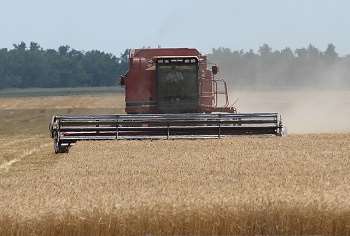
This year’s abundant hard red winter wheat crop, slow export demand and ample supplies of low-priced feed grains available to compete with wheat for livestock feeding have combined to pull Kansas wheat prices lower this summer. Anticipated large harvests of corn, grain sorghum, soybeans and other crops this fall are likely to further clog the state’s grain storage and handling systems, according to Kansas State University associate professor Dan O’Brien.
One apparent result of the tight grain storage situation is that the Chicago Mercantile Exchange July Kansas hard red winter wheat futures contract did not converge with the actual cash price being paid for wheat at designated delivery elevator locations in central Kansas and Kansas City, Missouri as it normally would. The disconnect between futures and cash prices could have implications for crop insurance programs, O’Brien said..
For example, on July 1, at the beginning of the delivery period for Chicago Mercantile Exchange July 2016 Kansas hard red winter wheat futures, the contract closed at $3.94 a bushel, down from $4.61 on May 2 – the price of May 2016 wheat futures at the beginning of its delivery period.
Also on July 1, cash prices for wheat truck bids in Kansas City, Missouri were $3.66 per bushel.
On Aug. 8, cash basis levels had fallen further to $0.58 per bushel under Sept. 2016 CME Kansas HRW wheat futures. Basis levels had fallen $0.80-$0.85 per bushel under designated delivery locations in Salina/Abilene, Hutchinson, and Wichita, Kansas.
“The current wide wheat basis situation in Kansas seems to be the result of large inventories of wheat in combination with other grains accumulating in Kansas grain elevators across the state in general, and at designated delivery elevators in particular,” said O’Brien, an agricultural economist with K-State Research and Extension. Basis is the difference between a local cash price for a commodity and the price of a specific futures contract of the same commodity and any given point in time. “These large inventories have resulted in greater demand for grain storage, and raised the true value of physical grain storage space above the rates of storage written into the CME Kansas hard red winter wheat contract for delivered wheat. As a result, a positive ‘wedge’ has formed between the true value or “price” of physical grain storage space and the futures contract storage rate on delivered hard red winter wheat.”
Because of this, long futures position holders who have been delivered upon by short position holders have an incentive to continue to pay storage and “store” the warehouse receipts they have been forced to take rather than to “load out” or actually sell the wheat in the cash market, he said. This incentive to hold and store the delivered wheat rather than move it into the cash market is a major contributing factor in the widening of wheat basis levels during delivery periods for CME Kansas HRW wheat at delivery locations in Kansas and at Kansas City, Missouri. The impact on wheat basis levels at these key locations filter out to other grain elevators across the state.
One solution to the formation of such positive “wedges” between the value of physical storage space and lower futures contractual storage rates on delivered wheat, O’Brien said, would be to raise the contractual storage rates to a level as high as the value of physical storage space is likely to ever be in the foreseeable future. Such action by the CME on the Kansas HRW wheat futures contract would help to solve the problem of non-convergence between cash wheat prices and wheat futures in Kansas wheat markets that occurs at designated grain elevator delivery locations, and that affects grain elevators across the state
“If these periods of non-convergence for CME Kansas HRW wheat were eliminated, it would benefit Kansas farmers in terms of more effective and efficient crop revenue insurance programs and wheat marketing strategies,” he said. “It would also help Kansas farmers and agribusinesses make more accurate and profitable decisions in regards to crop enterprise selection, as in making profit maximizing decisions in regards to use of farm assets.”
Source:k-state.edu